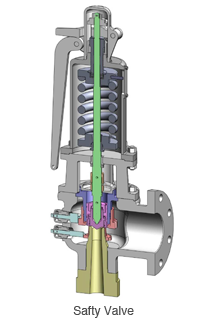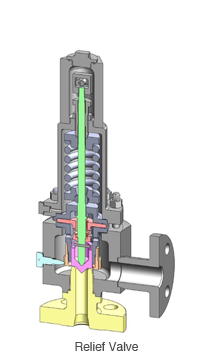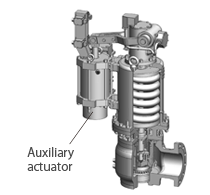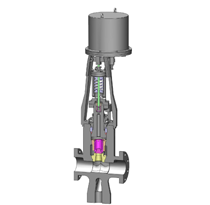Safety Valve / Relief Valve
Safety valves and relief valves are so designed so that the disc lifts automatically when the inner pressure rises to a set pressure, and then closes when the pressure level drops to a predetermined value.
We offer a diverse lineup that supports various fluid types including steam, gas, water, and more.

Specifications
| Name | Safty Valve |
| Body Material | ASTM, ASME, JIS, Cast Steel / Forged Steel |
Carbon Steel,
1Cr0.5Mo Steel,
2.5Cr1Mo SteelFluidWater, SteamPressure Class,
Size(Standardized)40 mm – 154 mm
*Standardized according to set pressure.Connection FormInlet end: butt weld, flanged
Outlet end: flanged
*The outlet end can be made to order.

| Name | Relief Valve |
| Body Material | ASTM, ASME, JIS, Cast Steel / Forged Steel |
Carbon Steel,
1Cr0.5Mo Steel,
2.5Cr1Mo SteelFluidWater
Pressure Class,
Size(Standardized)15 mm – 50 mm
*Standardized according to set pressure.Connection FormInlet end: butt weld, flanged
Outlet end: flanged
*The outlet end can be made to order.
• The above specifications are for standard products. Please inquire for other specifications..
Safety valves and relief valves protect various equipment from overpressure and are deemed essential for this reason. We have been manufacturing various specialized valves, including the main steam relief valve (SRV) for nuclear power plants and the power control valve (PCV) for thermal power plants.
SRV (Main steam relief valve)

The SRV is designed to prevent excessive pressure buildup inside nuclear reactors and thus plays an essential role in nuclear power plants.
It comes equipped with an auxiliary actuator in addition to a spring, which is its main feature, enabling the valve to be forcibly opened by external operation.
PCV (Power control valve)

PCVs are mounted on the superheated steam lines of thermal power plants. These valves are structurally different from safety valves and relief valves in that they use a magnet instead of a spring to operate.
The pressure sensor detects an electric signal that triggers magnetic excitation, causing the valve to open. These valves can also be opened manually using the control panel.

